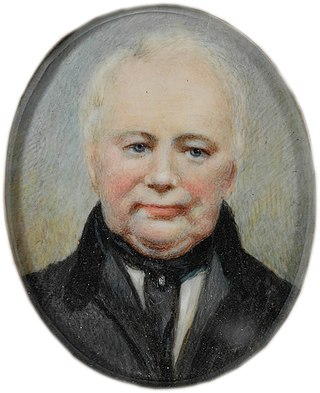
William Lawson, MLC was a British soldier, explorer, land owner, grazier and politician who migrated to Sydney, New South Wales in 1800. Along with Gregory Blaxland and William Wentworth, he pioneered the first successful crossing of the Blue Mountains by British colonists.

Major General Lachlan Macquarie, CB was a British Army officer and colonial administrator from Scotland. Macquarie served as the fifth Governor of New South Wales from 1810 to 1821, and had a leading role in the social, economic, and architectural development of the colony. He is considered by historians to have had a crucial influence on the transition of New South Wales from a penal colony to a free settlement and therefore to have played a major role in the shaping of Australian society in the early nineteenth century.

Boggabilla is a small town in the far north of inland New South Wales, Australia in Moree Plains Shire. At the 2021 census, the town had a population of 529, of which 43.5% identified as Aboriginal or Torres Strait Islander descent.

The Waterloo Creek massacre refers to a series of violent clashes between mounted settlers, civilians and Indigenous Gamilaraay peoples, which occurred southwest of Moree, New South Wales, Australia, during December 1837 and January 1838. The Waterloo Creek Massacre site is listed on the New South Wales Heritage Register as a place of significance in frontier violence leading to the murder of Gamilaraay people. The events have been subject to much dispute, due to wildly conflicting accounts by various participants and in subsequent reports and historical analyses, about the nature and number of fatalities and the lawfulness of the actions. Interpretation of the events at Waterloo Creek was raised again during the controversial "history wars" which began in the 1990s in Australia.
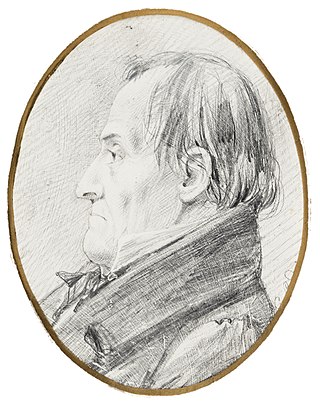
William Cox was an English soldier, known as an explorer, road builder and pioneer in the early period of British settlement of Australia.
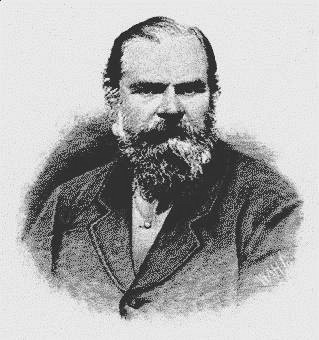
Frederick Walker was a British public servant of the Colony of New South Wales, property manager, Commandant of the Native Police, squatter and explorer, today best known as the first Commandant of the Native Police Force that operated in the colonies of New South Wales and Queensland. He was appointed commandant of this force by the NSW government in 1848 and was dismissed in 1854. During this time period the Native Police were active from the Murrumbidgee/Murray River areas through the Darling River districts and into what is now the far North Coast of NSW and southern and central Queensland. Despite this large area, most operations under Walker's command occurred on the northern side of the Macintyre River. Detachments of up to 12 troopers worked on the Clarence and Macleay Rivers in NSW until the early 1860s and patrols still extended as far south as Bourke until at least 1868. After his dismissal from the Native Police, Walker became involved in the pastoral industry as a squatter, as well as organising a private native police force and leading a number of expeditions into Northern Queensland.

Australian native police were specialised mounted military units consisting of detachments of Aboriginal troopers under the command of White officers appointed by colonial governments. These units existed in various forms in colonial Australia during the nineteenth and, in some cases, into the twentieth centuries. From temporary base camps and barracks, Native Police were primarily used to patrol the often vast geographical areas along the colonial frontier in order to conduct indiscriminate raids and punitive expeditions against Aboriginal people. The Native Police proved to be a brutally destructive instrument in the disintegration and dispossession of Indigenous Australians. Armed with rifles, carbines and swords, they were also deployed to escort surveying groups, gold convoys and groups of pastoralists and prospectors.

The Australian frontier wars were the violent conflicts between Indigenous Australians and primarily British settlers during the colonial period of Australia.

The Bathurst Rebellion of 1830 was an outbreak of bushranging near Bathurst in the British penal colony of New South Wales.

The military history of Australia during the Boer War is complex, and includes a period of history in which the six formerly autonomous British Australian colonies federated to become the Commonwealth of Australia. At the outbreak of the Second Boer War, each of these separate colonies maintained their own, independent military forces, but by the cessation of hostilities, these six armies had come under a centralised command to form the Australian Army.

The Bathurst War (1824) was a war between the Wiradjuri nation and the United Kingdom of Great Britain and Ireland. Following the successful Blaxland, Lawson, and Wentworth expedition to find a route through the "impenetrable" Blue Mountains in 1813, this allowed the colony to expand onto the vast fertile plains of the west.
The Border Police of New South Wales was a frontier policing body introduced by the colonial government of New South Wales with the passing of the Crown Lands Unauthorised Occupation Act 1839.
Richard Purvis Marshall was a British pastoral squatter and high ranking Native Police officer in the colonies of New South Wales and Queensland. He was co-founder of the Gundi Windi cattle and sheep run which later evolved into the town of Goondiwindi. He was appointed to the Native Police in 1850 and became Commandant of the force in 1855. He retired from the Native Police in 1856 and held various Justice of the Peace and police magistrate roles in Goondiwindi until his death in 1872.

Edric Norfolk Vaux Morisset was a high-ranking officer in both the paramilitary and civilian police forces of the New South Wales and Queensland colonies of the British Empire. He was Commandant of the paramilitary Native Police from 1857 to 1861 and concurrently became the first Inspector General of Police in Queensland in 1860. Morisset afterwards was appointed Superintendent of Police at Bathurst and then later on at Maitland. From 1883 until his death in 1887, Morisset was Superintendent of the Southern Districts and Deputy Inspector General of Police in New South Wales.

John Murray was a Scottish officer in the Australian native police in the British colonies of New South Wales and Queensland. He was an integral part of this paramilitary force for nearly twenty years, supporting European colonisation in south-eastern, central and northern Queensland. He also had an important role in recruiting troopers for the Native Police from the Riverina District in New South Wales.
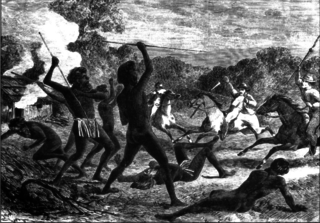
Myall Creek Massacre and Memorial Site is the heritage-listed site of and memorial for the victims of the Myall Creek massacre at Bingara Delungra Road, Myall Creek, Gwydir Shire, New South Wales, Australia. The memorial, which was unveiled in 2000, was added to the Australian National Heritage List on 7 June 2008 and the New South Wales State Heritage Register on 12 November 2010.
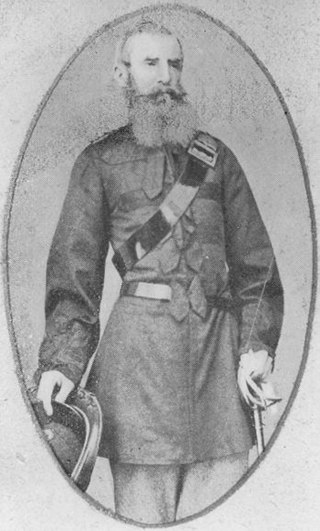
John By Durnford Marlow was an officer in the paramilitary Native Police force in the British colony of Queensland. He served in this corps for fourteen years and was stationed at frontier sites such as the Maranoa Region, Port Denison and on the Burdekin River. Marlow, by leading armed escorts of troopers, was also intrinsically involved in the expeditions which led to the establishment of the towns of Cardwell and Townsville.
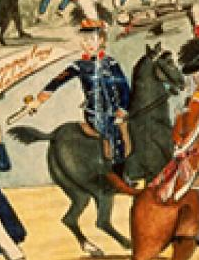
The Governor's Body Guard of Light Horse was a military unit maintained in the Colony of New South Wales between 1801 and 1834, and reputedly the "first full-time military unit raised in Australia". It was established by Governor Philip Gidley King by drawing men from the New South Wales Corps, the British garrison in the colony. Normally consisting of one or two non-commissioned officers and six privates, the Guard provided an escort to the governor and carried his despatches to outposts across the colony. From 1802, the men of the Guard were drawn from convicts pardoned by King. Men from the unit were deployed during the Castle Hill convict rebellion of 1804 and a trooper of the Guard assisted in the capture of two of the rebel leaders.

From the late 1700s until the end of the 19th century, the British Empire established, expanded and maintained a number of colonies on the continent of Australia. These colonies included New South Wales, Van Diemen's Land, Western Australia, South Australia, Victoria and Queensland. Many of these were initially formed as penal settlements, and all were built on land occupied by Indigenous Australians. In order to keep the large number of transported convicts under control, enforce colonial law and fight the Australian frontier wars, British military elements, including the British Army, were deployed and garrisoned in Australia. From 1790 to 1870 over 30 different regiments of the British Army consisting of a combined total of around 20,000 soldiers were based in the Australian British colonies.



















